In this article, I'll discuss the various Solemn cards, how they stack up to the original, and dive right into how good Solemn Judgment is.
A Solemn Brigade
Though the first Solemn counter trap was Solemn Judgment, today there are a whole lot of them. Each of them thematically shares the ability to negate and destroy a card at Spell Speed 3, but with differing costs and targets.
To start, I'm going to cover the basics of what each card can do.
Solemn Strike
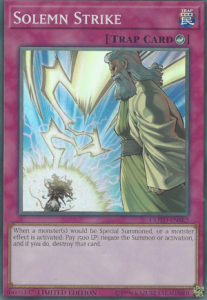 Most people are quite used to seeing this card by now. Solemn Strike is able to negate & destroy both "Inherent" Special Summons, and monster effects, at the cost of 1500 LP. However, Strike can't be used to stop Spell and Trap cards.
Most people are quite used to seeing this card by now. Solemn Strike is able to negate & destroy both "Inherent" Special Summons, and monster effects, at the cost of 1500 LP. However, Strike can't be used to stop Spell and Trap cards.Protip: An "Inherent" Special Summon is a non-official term. It describes any type of Special Summon which doesn't start a chain.
For example: Synchro Summoning a Synchro Monster doesn't start a chain, so it's an Inherent Summon. Summoning Cyber Dragon with its ability doesn't start a chain, so it's an Inherent Summon. Using the Effect of Tour Guide From the Underworld to Summon a Monster from the deck does start a chain, which means that it is not an Inherent Summon. Although Strike can stop both inherent and non-inherent summons, Judgment cannot,
Solemn Warning
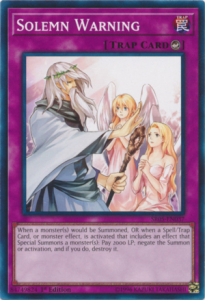 In comparison, Solemn Warning can negate any type of "Inherent" Summon - both Normal Summons and Special Summons. On top of that, Warning can negate any type of card which can summon a monster: Even Spells and Traps!
In comparison, Solemn Warning can negate any type of "Inherent" Summon - both Normal Summons and Special Summons. On top of that, Warning can negate any type of card which can summon a monster: Even Spells and Traps! You should take care when using Warning: You can only Warning cards which Summon Monsters. In comparison, Solemn Strike can also negate monster effects which don't summon monsters. It's a slight difference, but a crucial one nonetheless.
Protip: Warning can be used to negate the activation of "Macro Cosmos", since Macro Cosmos could potentially Summon a monster when it resolves!
Solemn Scolding
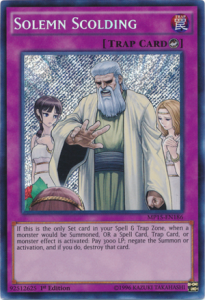 This is the newest of the "Solemn" Counter Trap cards. Solemn Scolding is able to negate pretty much anything in the entire game: Monster, Spell, and Trap Effects, as well as Inherent Summons.
This is the newest of the "Solemn" Counter Trap cards. Solemn Scolding is able to negate pretty much anything in the entire game: Monster, Spell, and Trap Effects, as well as Inherent Summons. However, Scolding also has a huge 3000 LP cost, as well as another huge drawback: Scolding can't be activated if its controller has any other face-down backrow! This clause alone gives Scolding a very tough time finding a home. You can't fit it into heavy-backrow control decks, yet it also doesn't act as a combo piece for faster decks, and is inherently slow as a trap card.
Regardless, you might remember it from some metagames of the past - most notoriously, Patrick Hoban's build of 2015 Djinn Lock Nekroz. More recently, Scolding has seen play as a counter for Evenly Matched.
Solemn Judgment
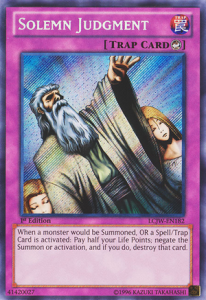 Finally, we arrive at the card whch started it all: Solemn Judgment.
Finally, we arrive at the card whch started it all: Solemn Judgment.
When a monster would be Summoned,
OR a Spell/Trap Card is activated:
Pay half your Life Points; negate the Summon or activation, and if you do, destroy that card.
There are some things of note to point out here before we compare and contrast Solemn Judgment to the other counter traps. First, you can always pay for Judgment. The other Solemn cards have specific life point requirements, but since Judgment costs half of your life, you're always able to activate it - Even if you only have 1 Life Point left!
Second, Solemn Judgment cannot negate Monster Effects. You might remember this from a little earlier when talking about Solemn Strike. You can't negate any monster effect, though you can negate the "Inherent Summon" of a monster. These are the things you CAN negate with Judgment:
- Normal Summons
- Flip Summons
- Pendulum Summons of 1 or more monsters
- Synchro / Xyz / Link Summons
- Any type of Spell Card
- Any type of Trap Card
- "Inherent" Summons (EG, Cyber Dragon Summoning itself)
Comparing the Solemn Brigade
The only things you can't negate with a Solemn Judgment are Monster Effects (and Nomal Sets). However, that's still a very broad category. Let's compare Judgment to each of the other Solemn cards:
Solemn Judgment VS Solemn Strike
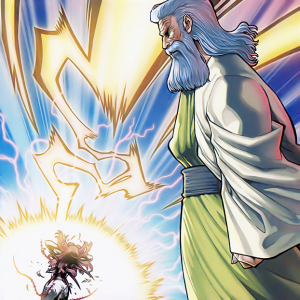 Judgment and Strike are very different in function. They can almost be seen an "inverses" of each other; Judement can negate everything apart from Monster Effects, and Strike almost exclusively negates monster effects.
Judgment and Strike are very different in function. They can almost be seen an "inverses" of each other; Judement can negate everything apart from Monster Effects, and Strike almost exclusively negates monster effects. Because of this, you'd likely be playing both Judgment and Strike in the same deck, which is what the majority of OCG players seem to do (more on that later).
Solemn Judgment VS Solemn Warning

Warning only negates Summons, while Judgment can negate both Summons and Spell/Trap effects. The only realistic upside of Warning is it'll usually cost less than a Judgment.
As a result, Warning may soon become more of a format-dependent or side-deck card: In matchups where negating a Normal Summon is crucial (such as in Zoodiac format), Warning becomes much more important.
Solemn Judgment VS Solemn Scolding
 Scolding is a much more flexible card than Judgment. It's able to negate everything that Judgment can, as well as Monster effects. The clear downside of Scolding is its "you can't have any other backrow" clause, as well as the steep life point cost. You are always able to pay for Judgment: The same is not true for Scolding.
Scolding is a much more flexible card than Judgment. It's able to negate everything that Judgment can, as well as Monster effects. The clear downside of Scolding is its "you can't have any other backrow" clause, as well as the steep life point cost. You are always able to pay for Judgment: The same is not true for Scolding. It's potentially possible to use Scolding in a deck with Judgment as well: Resolve the Judgment first, then you'll have no other backrow, being able to later resolve the Scolding. Regardless, that's still a very, very hefty life point cost, meaning that Judgment will usually outclass this card in every regard.
Solemn Judgment in the OCG
Solemn Judgment has been limited in the OCG for a very long time. This can give us insight regarding how to use the card in the TCG. The majority of OCG decks tend to side one Solemn Judgment, although there are many tournament-winning decks which opt not to play the card at all.
Going First vs Going Second
Ideally, you want to draw into your Solemn Judgment going first, and then set it as to protect your board. Judgment doesn't really do too much if you're going second, as your opponent has likely already built a strong field of monsters. At that point in the game, paying 4000ish life points really isn't worth the one-for-one in card advantage.
Because of this, many OCG players choose to only side their one Solemn Judgment, and bring it into the maindeck whenever they go first. A brief analysis of some OCG decklists tells me that around 60% of players choose to side Judgment, while around 30% don't play it at all.
Hand-Traps
As opposed to handtraps
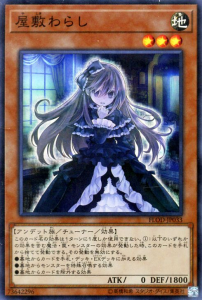 A "faster" version of Solemn Judgment can possibly be seen in Ash Blossom & Joyous Spring. All of the "Solemn" cards require being set first, making them inherently much slower than Hand-Traps. This doesn't mean that Judgment is worse than Ash Blossom, but it does give us more reason to side the card rather than maindeck it.
A "faster" version of Solemn Judgment can possibly be seen in Ash Blossom & Joyous Spring. All of the "Solemn" cards require being set first, making them inherently much slower than Hand-Traps. This doesn't mean that Judgment is worse than Ash Blossom, but it does give us more reason to side the card rather than maindeck it. Both Ash Blsoom & Joyous Spring and Ghost Ogre & Snow Rabbit can counter a lot of your opponent's plays - Solemn Judgment doesn't have an especially larger Domain of Negation than other commonly played handtraps, and can't even be used to counter handtraps. Because of this, many OCG players have chosen to only play Hand-Traps, and forgo Counter Traps entirely.
Against handtraps
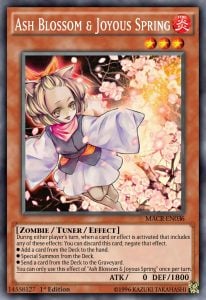 As I alluded to earlier, Solemn Strike still sees a lot of play in OCG decks, even with Solemn Judgment legal in the format. One of the main reasons for this is the prevalence of Hand-Traps such as Ash Blossom & Joyous Spring in the metagame.
As I alluded to earlier, Solemn Strike still sees a lot of play in OCG decks, even with Solemn Judgment legal in the format. One of the main reasons for this is the prevalence of Hand-Traps such as Ash Blossom & Joyous Spring in the metagame. Although handtraps ideally stop plays on turn 1, Judgment can't do anything to negate them later on in the game - yet Solemn Strike can. On top of this, it's still possible to resolve 2 Solemn Strikes after paying 4000 Life for a Solemn Judgment. I can easily imagine the future TCG "Solemn Brigade" being 2-3 Solemn Strikes in the maindeck, with 1 Judgment in the Sidedeck.
When to Activate Solemn?
One last point to mention is how it's important to use Judgments and Strikes in a particular order. It's important to consider the following:
- How many Life Points will I lose if I don't negate? Can I afford to pay that price?
- What is the end-goal of my opponent's Play? Can I stop it without using other cards?
- What other cards might my opponent have? Is my opponent baiting my Traps?
In particular, it's important to consider the other options that your opponent may have. A good opponent may try "baiting" out a Judgment, meaning that they'll attempt to make you use it prematurely to ensure that their other plays go through unopposed. On the flipside, it's important to consider that your opponent may have a Judgment - in such an instance, you may need to bait it out with other cards and effects.
In Closing
 Though it will undoubtedly see a lot of meta play, Solemn Judgment is likely confined to side-decks, and will possibly not act as much more than a replacement for Solemn Warning.
Though it will undoubtedly see a lot of meta play, Solemn Judgment is likely confined to side-decks, and will possibly not act as much more than a replacement for Solemn Warning.Judgment is still a skillful card to use: It poses the age-old question of "How much do I need to prevent this threat?". If you can answer that question correctly, Judgment will likely be the key to much success in the upcoming formats.
Until next time - Stay Groovy!




